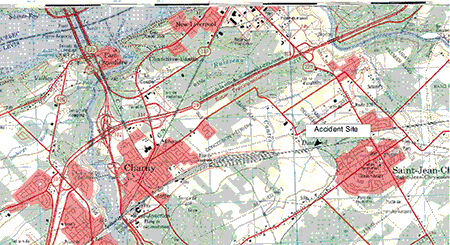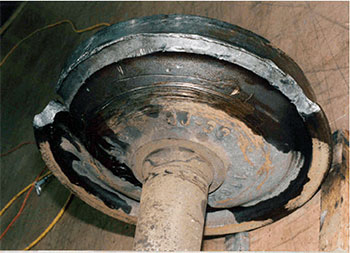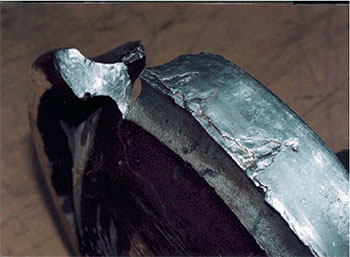Main-track derailment
Canadian National
Train Q-120-31-12
Mile 114.8, Montmagny Subdivision
Lévis, Quebec
The Transportation Safety Board of Canada (TSB) investigated this occurrence for the purpose of advancing transportation safety. It is not the function of the Board to assign fault or determine civil or criminal liability. This report is not created for use in the context of legal, disciplinary or other proceedings. See Ownership and use of content. Masculine pronouns and position titles may be used to signify all genders to comply with the Canadian Transportation Accident Investigation and Safety Board Act (S.C. 1989, c. 3).
Summary
At approximately 1330 eastern standard time on 12 November 2004, 10 multi-platform container cars of Canadian National train Q-120-31-12 bound for Halifax, Nova Scotia, derailed at Mile 114.8 of the Montmagny Subdivision, near Lévis, Quebec. The cars sustained minor damage, and two switches and 500 metres of track were damaged. No dangerous goods were spilled and there were no injuries.
Ce rapport est également disponible en français.
Factual information
On 12 November 2004, Canadian National (CN) train Q-120-31-12 (the train), bound for Halifax, Nova Scotia, stopped on the passing track of the Joffre Yard for a crew change. The relief crew consisted of a locomotive engineer and a conductor. Both were qualified for their respective positions and met established fitness and rest standards. The train was made up of 3 locomotives and 39 multi-platform container cars (113 platforms in all). It was approximately 7500 feet in length and weighed 6200 tons.
Shortly after departure, the train had gone 1.6 miles when it experienced a train-initiated emergency brake application. The train crew followed emergency procedures and determined that 10 container cars (27th to 36th cars), for a total of 30 platforms, had derailed. The event recorder on the lead locomotive indicated that the train was travelling at 16 mph at the time of the emergency brake application.
The train derailed while rolling over the crossover between the passing track and the main track of the Montmagny Subdivision at Mile 114.8 (see Figure 1). The Joffre Yard passing track is adjacent to and south of the main track. It is approximately 16 000 feet long. At the east end, where the derailment occurred, it connects to the main track through a crossover consisting of two turnouts with number 20 switches. The track consists of 136-pound continuous welded rail on hardwood ties. The maximum speed authorized for freight trains on the passing track is 15 mph.
The derailed cars remained upright and coupled. They were immediately east of the crossover, and the last derailed car came to rest over the passing track turnout switch point. Examination of the derailed cars revealed that the rim of the lead wheel of the trailing truck on the first derailed platform of car DTTX 25029 was broken and that a portion of the rim and a 38-inch section of the wheel flange were missing (see Photo 1). The mate wheel exhibited no flaws. The roadbed and right-of-way were inspected over a distance of 3.5 miles to the west of the passing track turnout, but the broken pieces of wheel rim were not recovered. East of the turnout, impact marks were visible on the ties, spikes and tie plates on the south, outside of the track.
The Montmagny Subdivision extends 116.3 miles between Rivière-du-Loup, Quebec, Mile 1.3, and the Joffre Yard, Mile 118.0. The main track consists of one track running east-west. The method of train control is the Centralized Traffic Control System (CTC) authorized by the Canadian Rail Operating Rules (CROR), under the supervision of a rail traffic controller in Montréal, Quebec.
The tracks, including the crossover, were inspected regularly at the intervals required by existing regulations. In the derailment area, no flaws were noted on the most recent visual inspections or the inspections by the track geometry car and the rail test car. The evaluation and safety check were conducted by Transport Canada (TC) two weeks before the derailment, and no defects were observed.
Over the past 20 years, CN has installed a network of wayside inspection systems (WISs) and wheel impact load detectors (WILDs) along the tracks, which check the condition of rolling stock. The WISs include detectors for dragging equipment and for hot boxes and hot wheels. The WILDs measure the impact generated by each wheel of a car and identify wheels with flats, and wheels whose running surface exhibits shelling or spalling, is out-of-round or is affected by an excess of metal. Defective wheels are removed from service before they can cause damage to rolling stock or track infrastructure. WISs are positioned at intervals of 10 to 15 miles on main tracks, and WILDs are placed at strategic locations.
Increased use of these new rolling stock inspection technologies and improvements in the rail car and motive power equipment have reduced the importance of certain visual inspections. As a result, in 2001, CN and Canadian Pacific Railway (CPR) requested an exemption from Rule R-41300 1.22 with regard to pull-by inspections at crew relief points.Footnote 1 An exemption was granted to CN and CPR by TC under subsection 22(2) of the Railway Safety Act (RSA), which allows the Minister to exempt a railway from the provisions of certain rules. The exemption was granted on the basis of a detailed risk assessment using the criteria set out in the Railway Safety Management System Regulations. The objectives of the risk assessment were to determine whether pull-by inspections at crew relief points could be eliminated without a reduction in the current level of safety and whether mitigation could be developed to protect the current level of safety.
The analysis reviewed current inspections and technologies, estimated the risks and suggested risk control strategies. It estimated that 8.4 per cent of total system en-route defects are detected by pull-by inspections at crew relief points and concluded that the greatest risk associated with the elimination of the inspections was the potential for undetected shifted loads. The analysis also showed that skid or shelled wheels were the most common defect found during these inspections. CN considered that the extensive network of WILDs and WISs will adequately mitigate risks associated with skid or shelled wheels; however, it was proposed to continue pull-by inspections at crew relief points on trains carrying dangerous goods. Consequently, the exemption was subject to some restrictions; for example, it does not apply to trains carrying dangerous goods or loads that are apt to shift, or when two consecutive WISs are defective. Also, the railway companies were required to file regular reports with TC on car inspections and on the condition of WISs.
TSB records show that, between January 2000 and December 2004, nine occurrences were identified by employees on pull-by inspections, at crew change locations, during train meets or by other employees working in the field. Six of these involved derailed rolling stock, one involved a seized wheel, and two involved a displaced centre plate. In one case, at Parent, Quebec, on 29 October 2004, the outgoing crew of train M-366-21-28 noticed that the wheels of the 22nd car were seized (occurrence R04Q0045).
According to the safety inspection calendar, the train underwent a safety inspection by certified personnel when it was formed at Brampton, Ontario. On its route, the train passed several WISs, the last being at Mile 22.2 of the Drummondville Subdivision, 17 miles west of the accident site. The closest WILD to the accident site is near Bagot, Quebec, Mile 117.2 of the Drummondville Subdivision, about 112 miles farther west. No faults were reported on the safety inspection or when the train passed the WISs or the WILD. When departing the Joffre Yard, given the exemption in effect, the train was not given a pull-by inspection when the train crew was relieved.
The failed wheel was a 33-inch, class C, curved-plate wheel, one wear (model CJ-33), with a running surface originally 1 ¼ inches (32 mm) thick. Wheels of this type are designed for 70-ton freight cars. The wheel was manufactured at ABC Rail (formerly Abex Southern Corporation), in Calera, Alabama, United States (code SO). These wheels are cast and then control-cooled. Control cooling is critical to reduce residual stresses and eliminate dissolved hydrogen in the molten metal. The wheel was cast in November 1995 and mounted on the axle in December 1995. The mounted axle with the failed wheel was sent to the Transportation Safety Board of Canada (TSB) Engineering Laboratory for analysis. The examination yielded the following conclusions (report LP 157/2004):
The running surface of the failed wheel exhibited shelling spots adjacent to the wheel flange, one with a diameter of 1.7 inches and the other with a diameter of 2.4 inches (see Photo 2). The 2.4-inch shelling spot was not continuous, but the 1.7-inch shelling spot exceeded the limit prescribed by the Association of American Railroads (AAR), which requires that wheels with continuous shelling spots on the running surface measuring 1 inch or more in diameter be taken out of service. There were no indications or flaws due to heating.
- The surface of the fracture on the outer portion of the wheel rim had a dark area, located about 5 mm below the running surface, with semi-circular features and changes in colouration consistent with progressive fatigue cracking. One crack extended from this area towards the centre of the wheel plate. Observation of the crack contact surfaces revealed chevron markings and secondary cracks with polished sides.
- Metallurgical analysis of rim samples revealed a high level of porosity due to voids left by bubbles of dissolved hydrogen trapped during manufacture of the wheel. Some cracks propagated from these voids. The hardness and chemical composition of the wheels were within AAR specifications.
Analysis
No obvious deficiencies were found in the operation of the train, the rails or the rolling stock before the derailment. Therefore, the analysis will focus on the failed wheel and issues related to the manufacture, maintenance and inspection of the wheels.
The marks observed on the roadbed, the damages to wheel L-3 and the position in which car DTTX 25029 came to rest suggest that the broken wheel derailed on the crossover switch between the passing track and the main track. After derailing, the wheel scraped the ties and ballast, causing the destruction of the tracks and the derailment of the next 29 platforms.
Based on the analysis by the TSB Engineering Laboratory, the major portion of the fracture of the outer part of the wheel rim was caused by instantaneous overstress. However, the direction of the chevron markings observed on the fracture surfaces indicates that the crack originated in the rim and progressed into the wheel plate. The walls of the secondary cracks were polished, indicating that they had been progressing for some time.
The high level of porosity observed shows that the wheel was not properly cooled, which resulted in trapped hydrogen bubbles and the creation of voids. As a result of service stresses, sub-surface cracks propagated from these voids and subsequently combined to form a larger crack below the running surface. Even though a portion of the wheel rim was not recovered, the presence of porosity and cracks and their positions indicate that the wheel failed when the sub-surface fatigue cracks intersected with the cracks caused by the shelling spots on the running surface.
The sub-surface cracks observed on the failed wheel could not have been detected by hot box detectors because they originate and propagate with no significant emission of heat. However, the failed wheel had exceeded the limits allowed by the AAR for shelling of the running surface, although neither the safety inspection conducted at Brampton nor the WILD near Bagot identified it as defective. Since there is nothing to indicate that these different inspections were not carried out in accordance with existing standards, there is reason to believe that there are still some cases where the existing safety barriers can be inadequate, either because of the performance of the barriers themselves or because some flaws can develop rapidly.
Since the derailment occurred less than two miles from the crew change point at the Joffre Yard, it is reasonable to conclude that the wheel had already failed when the crew was relieved and that its condition might have been noticed if a pull-by inspection had been done. It is true that, because of the improvements in the railway equipment and the increased use of WISs, some visual inspections have become redundant for the majority of equipment flaws, which may explain why CN requested and was given an exemption from the requirement to conduct pull-by inspections at crew change points. The exemption was granted on the basis of a detailed risk assessment, and mitigating measures were put in place. Nevertheless, some residual risks remain as there are still some cases, such as this accident or the nine occurrences observed between January 2000 and December 2004, where pull-by inspections can still play a role.
Findings
Findings as to causes and contributing factors
- The train derailed following a wheel failure on car DTTX 25029.
- The wheel failed when sub-surface cracks propagated from porosity and intersected with cracks caused by shelling of the running surface.
Findings as to risk
- Wheels with internal flaws, or that have exceeded the limits prescribed by the Association of American Railroads for shelling of the running surface, can still be missed by safety inspections and wayside inspection systems and remain in service.
- If a pull-by inspection had been done when the crews changed, the condition of the wheel might have been noticed.
Safety action
The Association of American Railroads (AAR) has issued an instruction for the removal from service of all Southern wheels manufactured in 1995 when cars are in repair shops or tracks.
Canadian National and Canadian Pacific Railway have initiated programs that go beyond the requirements of the AAR. They are removing all Southern wheels from their equipment and have instructed their suppliers to not install Southern wheels on any cars owned or leased by them.
Transport Canada is monitoring the wheel failures on an ongoing basis by reviewing and analysing any reported failure with the railways to quickly identify any emerging trends and implement regulatory action should it be deemed necessary.
This report concludes the Transportation Safety Board's investigation into this occurrence. Consequently, the Board authorized the release of this report on .


